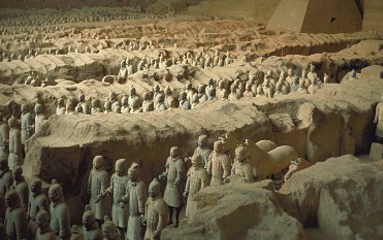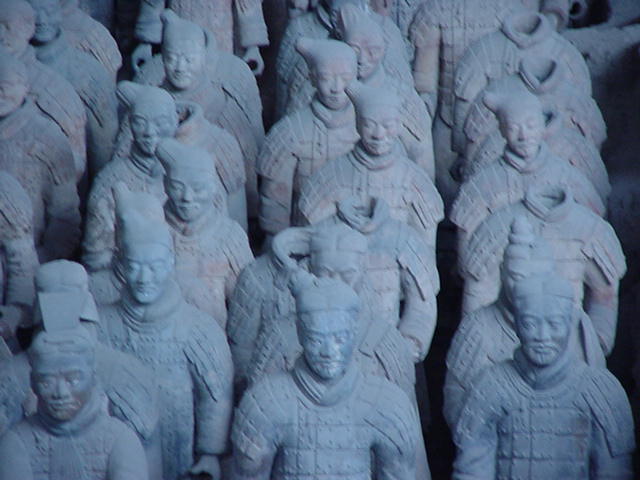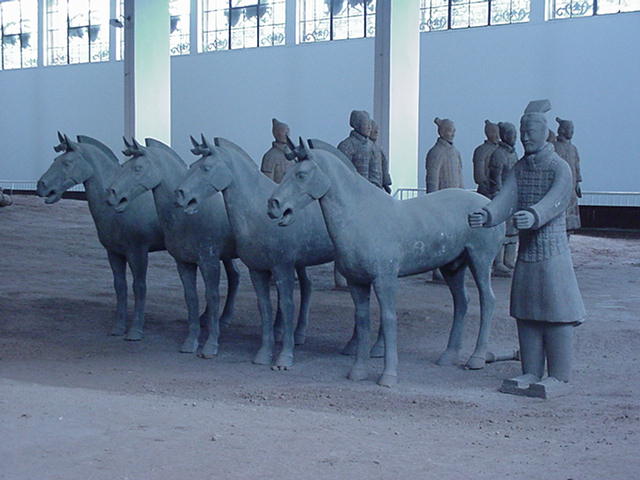|
~ The Terracotta Warriors of Emperor Qin |
|||
The
Terracotta Warriors of Emperor Qin What is it for?
Many cultures have sent their dead to the afterlife with the necessities of daily endeavor and the trappings of honor. Dishes, food, thrones, and barges have been excavated over the years. Pets, wives, concubines, and servants have gone to serve their masters in the next life as they served in this one. Death was perceived as a prolongation of life, and an Emperor’s mausoleum was his afterlife palace, mirroring the magnificence of his palatial life on earth. Lavishly provisioned with silks, musical instruments, servants, food and drink, tombs held everything for a well-lived life. As an old Chinese saying instructs, "treat death as life." It would be natural then, for war-plagued emperors to make their tombs battle ready. In China, sometime during the late 1920s, a peasant unearthed a life-sized terracotta sculpture of a warrior, while digging a well. Once the entire figure was uncovered, the water filling the well suddenly drained away. This was regarded as an evil omen and the statue was reburied. Then in 1974, peasants sinking a well for the Yanzhai Commune uncovered part of a pit of life-sized terracotta soldiers and horses. They had discovered a portion of the burial retinue of the first Emperor of China, Qin Shihuang. Who
is Qin Shihuang? In keeping with the grandeur of his life, the First Emperor had a lavish internment. Qin was entombed in Lintong County, Shaanxi Province about 35 kilometers east of the city of Xi’an. Qin ordered an entire army to protect his mausoleum, which lies still uncovered at Mount Li. Although it had been customary to put the servants of a king to death so that they might serve him in the afterlife, human sacrifice was less common by the time of Qin’s death. Rather than sacrifice an entire army, he was buried with a symbolic force of detailed, life-sized, terracotta soldiers and horses assembled to protect him in the next world. Excavation
of Qin's Tomb Pit #1, the largest, contains mainly infantry. Nearly 1,000 of an estimated 6,000 figures of armored and unarmored infantrymen, bowmen, crossbowmen, archers, and charioteers have been unearthed. Pit #2 is smaller, with a more complex layout of military personnel divided into four units of archers, chariots and cavalrymen, approximately 1,000 soldiers, 400 horses and 80 chariots in all. Pit #3 contains 68 figures which probably represent a command unit of officers. The
Eternal Army The figures were made by using a combination of molds and hand sculpting. The heads, for instance, were each cast from one of perhaps a dozen different molds, then hand sculpting of the eyes and noses, the addition of a variety of mustaches, eyebrows, ears, hair, and headgear provided individual distinctions.
In the same way, a variety of limbs and armor could be combined to produce an infinity of individual soldiers. Constructed from a delicately textured clay, and painted after firing, Qin’s army must have provided a very imposing and realistic presentation. The paint has flaked off over the centuries, but remaining traces show that there were different color schemes, perhaps distinguishing army units. The faces of Qin’s army have been classified into as many as 30 types but each was individually expressive, alert, intelligent, resourceful, and sincere, reflecting the personalities of ideal warriors. Weaponry Above and beyond any other legacies the emperor may have left behind, the terracotta armies survive as incredible works of art. Intricate details in armor, facial features, rank insignia, and positioning offer us a rich library of historic information and a peek into a segment of life in the early years of the Chinese empire. Adapted
from, Related
Books
|
|||


 Qin’s
soldiers are well proportioned and stand slightly taller than average
height for the period. His gifted artisans were able to give the
eternal army a feeling of being just about to move. This aura of
"motion in stillness" was achieved by postures of the
figures, alertness of the expressions, and arrangement of the army
as ready to march into battle. Contributing to this feeling is that
one must climb into the excavation and actually walk among the soldiers
to view them closely.
Qin’s
soldiers are well proportioned and stand slightly taller than average
height for the period. His gifted artisans were able to give the
eternal army a feeling of being just about to move. This aura of
"motion in stillness" was achieved by postures of the
figures, alertness of the expressions, and arrangement of the army
as ready to march into battle. Contributing to this feeling is that
one must climb into the excavation and actually walk among the soldiers
to view them closely.